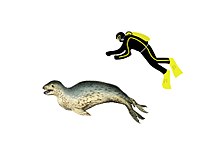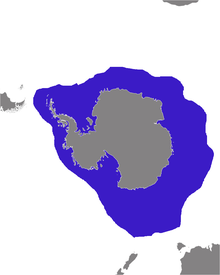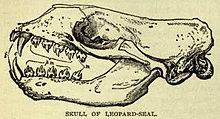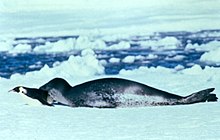Leopard seal
| Leopard seal[1] Temporal range: Early Pliocene – Recent
| |
|---|---|

| |

| |
| Size compared to a 6ft human | |
| Scientific classification | |
| Domain: | Eukaryota |
| Kingdom: | Animalia |
| Phylum: | Chordata |
| Class: | Mammalia |
| Order: | Carnivora |
| Clade: | Pinnipedia |
| Family: | Phocidae |
| Genus: | Hydrurga Gistel, 1848 |
| Species: | Hydrurga
|
| Binomial name | |
| Hydrurga (Blainville, 1820)
| |

| |
| Hydrurga leptonyx range map | |
| Synonyms | |
| |
The leopard seal (Hydrurga leptonyx), also referred to as the sea leopard, is the second largest species of seal in the Antarctic (after the southern elephant seal). Along with all of the other earless seals, it belongs to the family Phocidae, and is the only species in the genus Hydrurga. The name hydrurga means "water worker" and leptonyx is the Greek for "small clawed". It is second only to the killer whale among Antarctica's top predators.[3]
Description

The leopard seal is large and muscular, with a dark grey back and light grey on its stomach. Its throat is whitish with the black spots that give the seal its common name. Females are slightly larger than the males.[4] The overall length of this seal is 2.4–3.5 m (7.9–11.5 ft) and weight is from 200 to 600 kilograms (440 to 1,320 lb). They are about the same length as the northern walrus, but usually less than half the weight.[5][6]
Its front teeth are sharp like those of other carnivores, but its molars lock together in a way that allows them to sieve krill from the water, in the manner of the crabeater seal.
Distribution
The leopard seal lives in the cold waters surrounding the Antarctic continent. Where most seals remain restricted within the pack ice throughout the year,[7] [8] some (mostly young animals) move further north in the austral winter to subantarctic islands and the coastlines of the southern continents. They are difficult to survey by traditional visual techniques[9] because they spend long periods of time vocalizing under the water during the austral spring and summer - when visual surveys are carried out. This trait of vocalizing underwater for long periods however has made them available to acoustic surveys.[10] Leopard seals are solitary and widely distributed throughout the pack ice. Higher densities of leopard seals are seen in the Western Antarctic than in other regions.[11][12]
Behavior

Acoustic behavior
Leopard seals are very vocal underwater during the austral summer.[10] The male seals produce loud calls (153 to 177 dB re 1 μPa at 1 m) for many hours each day.[13] While singing the seal hangs upside down and rocks from side to side under the water. Their back is bent, the neck and cranial thoracic region (the chest) is inflated and as they call their chest pulses. Adult male leopard seals have only a few stylized calls, some are like bird or cricket-like trills yet others are low haunting moans.[14] The leopard seals have age-related differences in their calling patterns, just like birds. Where the younger male seals have many different types of variable calls - the adult male seals have only a few, highly stylized calls.[15] Each male seal produces individually distinctive songs. They arrange their few call types into individually distinctive sequences (or songs).[16] The acoustic behavior of the leopard seal is believed to be linked to their breeding behaviour. In male seals, vocalizing coincides with the timing of their breeding season, which falls between November and the first week of January; captive female seals vocalize when they have elevated reproductive hormones.[14]
Breeding and habits
The females give birth to a single pup during the austral summer on the floating ice floes of the Antarctic pack ice, and protect their pups until they are able to fend for themselves.
The leopard seal is bold, powerful and curious. In the water, there is a fine line between curiosity and predatory behaviour, and it may 'play' with penguins it does not intend to eat. There are also records of leopard seals attacking divers. Paul Nicklen, a National Geographic magazine photographer, captured pictures of a leopard seal bringing live, injured, and then dead penguins to him, possibly in an attempt to teach the photographer how to hunt.[17]
Foraging behavior

The leopard seal is second only to the killer whale among Antarctica's top predators.[3] Its canine teeth are 2.5 cm (1 in).[18] It feeds on a wide variety of creatures. Young leopard seals probably eat mostly krill, squid, and fish. Adult seals probably switch from krill to more substantial prey, including king, adelie, rockhopper, gentoo, emperor, and chinstrap penguins, and less frequently, Weddell, crabeater, Ross, and young Southern elephant seals. Leopard seals have also been filmed eating fur seal pups.[19]
Around the sub-Antarctic island of South Georgia, the Antarctic fur seal (Arctocephalus gazella) is the main prey. Other prey include penguins and fish. Antarctic krill (Euphausia superba), southern elephant seal (Mirounga leonina) pups and seabirds other than penguins have also been taken as prey.[20]
When hunting penguins, the leopard seal patrols the waters near the edges of the ice, almost completely submerged, waiting for the birds to enter the ocean. It kills the swimming bird by grabbing the feet, then shaking the penguin vigorously and beating its body against the surface of the water repeatedly until the penguin is dead. Previous reports stating the leopard seal skins its prey before feeding have been found to be incorrect. Lacking the teeth necessary to slice its prey into manageable pieces, it flails its prey from side to side tearing and ripping it into smaller pieces.
Phylogeny
The leopard seal is classified within the family Phocidae. Its closest relatives are the Ross seal, crabeater seal and the Weddell seal, which together are known as the lobodontine seals. All these seals descend from the superfamily Pinnipeda, which evolved from bear-like ancestors. They have diverged from other taxa in the order Carnivora.
The leopard seal share homologous features with the lobodontine seals. They all have dark fur on the tops of their bodies and lighter fur on their underbellies. Though the colors vary between these species, the colored fur serves the same function of camouflaging the individual to conceal it from both predator and prey.
Attacks on humans
Leopard seals are potentially highly dangerous towards humans, but attacks are rarely reported.[21] Examples of aggressive behaviour, stalking and attacks have been documented.[22] Notable incidents include:
- A large leopard seal attacked Thomas Orde-Lees (1877–1958), a member of Sir Ernest Shackleton's Imperial Trans-Antarctic Expedition of 1914–1917 when the expedition was camping on the sea ice.[21] The "sea leopard", about 12 ft (3.7 m) long and 1,100 lb (500 kg), chased Orde-Lees on the ice. He was saved only when another member of the expedition, Frank Wild, shot the animal.
- In 1985, Scottish explorer Gareth Wood was bitten twice on the leg when a leopard seal tried to drag him off the ice and into the sea. His companions managed to save him by repeatedly kicking the animal in the head with the spiked crampons on their boots.[21][22]
- In 2003, a leopard seal dragged snorkeling biologist Kirsty Brown of the British Antarctic Survey nearly 200 ft (61 m) underwater to her death, in what was identified as the first known human fatality from a leopard seal.[21][22]
Leopard seals have shown a predilection for attacking the black, torpedo-shaped pontoons of rigid inflatable boats, necessitating researchers to equip their craft with special protective guards to prevent them from being punctured.[22][23]
Notes and references
- ^ Wozencraft, W. C. (2005). "Order Carnivora". In Wilson, D. E.; Reeder, D. M. (eds.). Mammal Species of the World: A Taxonomic and Geographic Reference (3rd ed.). Johns Hopkins University Press. ISBN 978-0-8018-8221-0. OCLC 62265494.
- ^ Hückstädt, L. (2015). Hydrurga leptonyx. The IUCN Red List of Threatened Species doi:10.2305/IUCN.UK.2015-4.RLTS.T10340A45226422.en
- ^ a b "Leopard seals". Australian Antarctic Division. Retrieved 14 August 2017.
- ^ Tunstall, T. "Hydrurga leptonyx". Animal Diversity Web. University of Michigan Museum of Zoology. Retrieved 2009-04-27.
- ^ Nowak, Ronald M (2003). Walker's Marine Mammals of the World. Johns Hopkins University Press: Baltimore, MD.
- ^ Leopard Seals, Hydrurga leptonyx. marinebio.org
- ^ Rogers, T.L.; Hogg, C.; Irvine, A. (2005). "Spatial movement of adult leopard seals (Hydrurga leptonyx) in Prydz Bay, Eastern Antarctica". Polar Biology. 28 (6): 456–463. doi:10.1007/s00300-004-0703-4.
{{cite journal}}: Unknown parameter|last-author-amp=ignored (|name-list-style=suggested) (help) - ^ Meade, J.; Ciaglia, M.B.; Slip, D.J.; Negrete, J.; Márquez M.E.I., Rogers, T. (2015). "Spatial patterns in activity of leopard seals Hydrurga leptonyx in relation to sea ice". Marine Ecology Progress Series. 521: 265–275. doi:10.3354/meps11120.
{{cite journal}}: CS1 maint: multiple names: authors list (link) - ^ Southwell, C.; Paxton, C.; Borchers, D.; Boveng, P. Rogers, T.; de la Mare, W. (2008). "Uncommon or cryptic? Challenges in estimating leopard seal abundance by conventional but state-of-the-art methods". Deep-Sea Research Part I: Oceanographic Research Papers. 55 (4): 519–531. Bibcode:2008DSRI...55..519S. doi:10.1016/j.dsr.2008.01.005.
{{cite journal}}: Unknown parameter|last-author-amp=ignored (|name-list-style=suggested) (help)CS1 maint: multiple names: authors list (link) - ^ a b Rogers TL, Ciaglia MB, Klinck H, Southwell C (2013). "Density Can Be Misleading for Low-Density Species: Benefits of Passive Acoustic Monitoring". PLoS ONE. 8 (1): e52542. Bibcode:2013PLoSO...852542R. doi:10.1371/journal.pone.0052542. PMC 3541380. PMID 23326339.
{{cite journal}}: CS1 maint: unflagged free DOI (link) - ^ Southwell, C.; Bengtson, J.; Bester, M.; Schytte Blix, A.; Bornemann, H.; Boveng, P.; Cameron, M.; Forcada, J.; Laake, J.; Nordøy, E.; Plötz, J.; Rogers, T.; Southwell, D.; Steinhage, D.; Stewart, B.S.; Trathan, P (2012). "A review of data on abundance, trends in abundance, habitat use and diet of ice-breeding seals in the Southern Ocean". CCAMLR Science. 19: 1–26.
- ^ Forcada, J.; Trathan, P.; Boveng, Boyd; I., Burns; J., Costa; D., Fedak; M., Rogers; T., Southwell, C. (2012). "Responses of Antarctic pack-ice seals to environmental change and increasing krill fishing". Biological Conservation. 149 (1): 40–50. doi:10.1016/j.biocon.2012.02.002.
{{cite journal}}: CS1 maint: multiple names: authors list (link) - ^ Rogers TL (2014). "Source levels of the underwater calls of a male leopard seal". The Journal of the Acoustical Society of America. 136 (4): 1495–1498. doi:10.1121/1.4895685.
- ^ a b Rogers, T. L.; Cato, D. H.; Bryden, M. M. (1996). "Behavioral significance of underwater vocalizations of captive leopard seals, Hydrurga leptonyx". Marine Mammal Science. 12 (3): 414–427. doi:10.1111/j.1748-7692.1996.tb00593.x.
{{cite journal}}: Unknown parameter|last-author-amp=ignored (|name-list-style=suggested) (help) - ^ Rogers, T. L (2007). "Age-related differences in the acoustic characteristics of male leopard seals, Hydrurga leptonyx". The Journal of the Acoustical Society of America. 122 (1): 596–605. doi:10.1121/1.2736976. PMID 17614516.
- ^ Rogers, Tracey L.; Cato, Douglas H. (2002). "Individual Variation in the Acoustic Behaviour of the Adult Male Leopard Seal, Hydrurga leptonyx". Behaviour. 139 (10): 1267–1286. doi:10.1163/156853902321104154. JSTOR 4535987.
- ^ National Geographic photographer's surprise encounter with deadly predator. dpreview.com (2012-10-18)
- ^ Kindersley, Dorling (2005) [2001]. Animal. New York City: DK Publishing. ISBN 0-7894-7764-5.
- ^ "POV: Why Are Leopard Seals Eating Fur Seal Pups?". video.nationalgeographic.com. Retrieved 2015-08-08.
- ^ Walker, T.R.; Boyd, I.L.; Mccafferty, D.J.; Huin, N.; Taylor, R.I.; Reid, K. (1998). "Seasonal occurrence and diet of leopard seals (Hydrurga leptonyx) at Bird Island, South Georgia". Antarctic Science. 10 (1): 75–81. doi:10.1017/S0954102098000108.
- ^ a b c d Carrington, Damian (2003-07-24). Inquiry into fatal leopard seal attack begins. NewScientist.com. Retrieved on 2013-02-24.
- ^ a b c d Owen, James (August 6, 2003). "Leopard Seal Kills Scientist in Antarctica". National Geographic Society. Retrieved 2007-12-10.
- ^ Briggs, Mike; Briggs, Peggy (2005). The Encyclopedia of World Wildlife. Parragon. p. 60. ISBN 1-40545-680-9.
General references
- Rogers, Tracey L. (2009). The leopard seal, Hydrurga leptonyx. In William F. Perrin, Bernd Würsig & J.G.M. Thewissen (Eds.), Encyclopedia of Marine Mammals (Second ed., pp. 673–674). San Diego: Academic Press
- Heacox, Kim. (2006). Deadly Beauty. National Geographic, November 2006
- Saundry, Peter. (2010) Leopard Seal. Encyclopedia of Earth. Topic ed. C. Michael Hogan, ed. in chief Cutler Cleveland, NCSE, Washington DC
External links
- Best Wildlife Photos of 2005 – "Underwater World" Winner: "Leopard Seal Pass"
- "Face-off with a deadly predator" (video); National Geographic photo assignment
- Voices in the Sea – the Leopard Seal (audio)
- IUCN Red List least concern species
- Lobodontins
- Pinnipeds of Antarctica
- Pinnipeds of Oceania
- Pinnipeds of South America
- Pinnipeds of Australia
- Mammals of Chile
- Mammals of South Australia
- Carnivorans of South America
- Fauna of Heard Island and McDonald Islands
- Megafauna of Australia
- Megafauna of South America
- Least concern biota of Oceania
- Least concern biota of South America
- Mammals described in 1820
- Extant Zanclean first appearances
- Pliocene mammals of South America
- Pliocene pinnipeds

